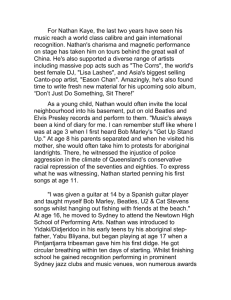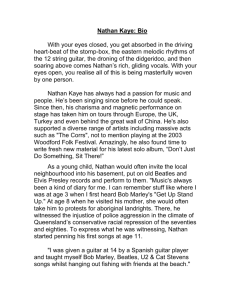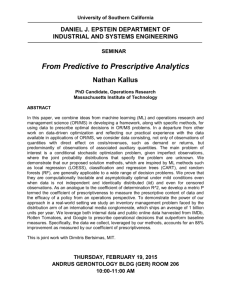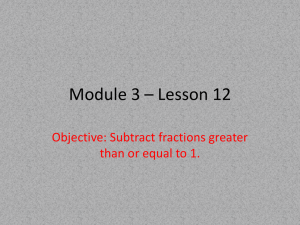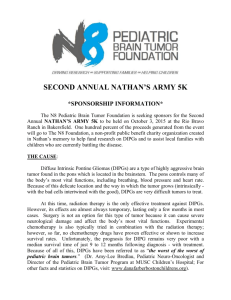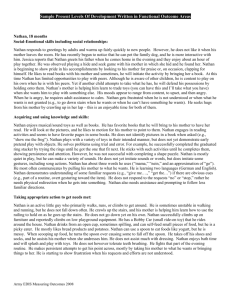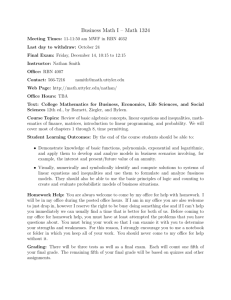My Freshman Year Review and Analysis Melissa Mattingly Michigan
advertisement
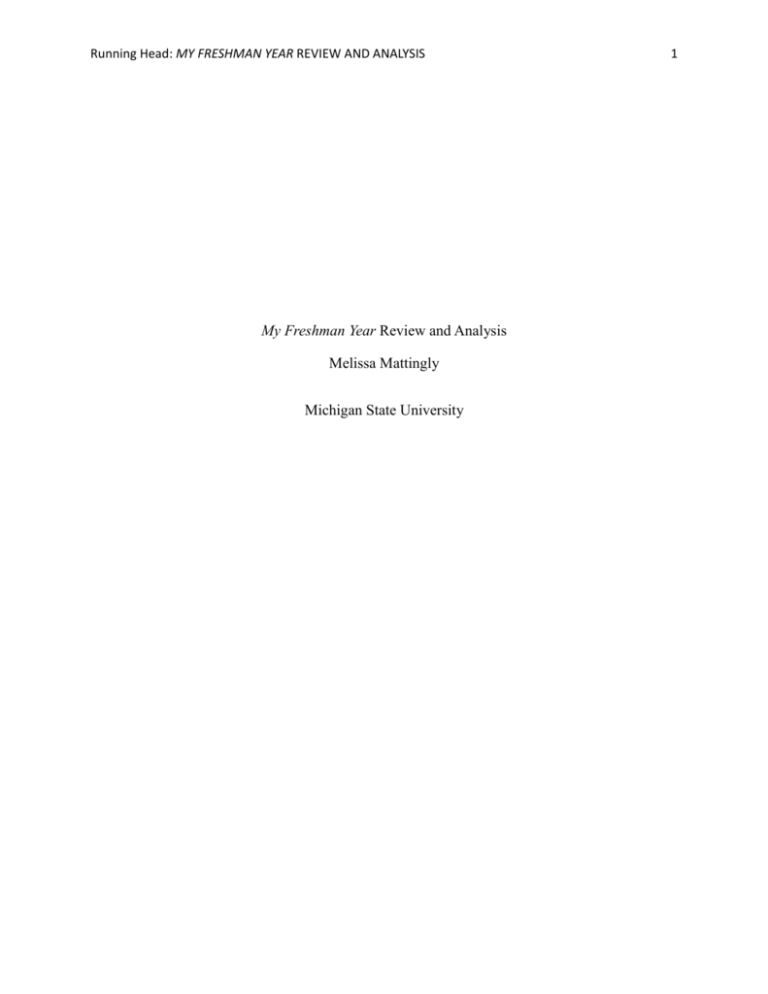
Running Head: MY FRESHMAN YEAR REVIEW AND ANALYSIS My Freshman Year Review and Analysis Melissa Mattingly Michigan State University 1 MY FRESHMAN YEAR REVIEW AND ANALYSIS 2 Undercover work is most commonly associated with law enforcement, but in My Freshman Year: What a Professor Learned by Becoming a Student, Rebekah Nathan (pseudonym assumed by the author for the purposes of the book) goes undercover as a freshman at her own institution to better understand the undergraduate student experience. Going undercover as an anthropological researcher and publishing the book under a pseudonym were ethically questionable practices and led to great controversy in the higher education community. In the first part of this book review and analysis, I will briefly summarize the content of the book, relate it to other relevant literature and point out its strengths and weaknesses. In the second part of this book review and analysis, I will analyze the student cultures that I found in the book, using course reading to identify elements of student culture and providing examples from the book of how culture is evident. Book Review Rebekah Nathan sets forth on her undercover anthropological study with the following research questions: “What is the current culture at AnyU (my pseudonym for my university) as an example of the American public university? How do contemporary American students understand their education, and what do they want from it? How do they negotiate college life? What does college really teach?” (p. 4). To answer her questions, she poses as an undergraduate student at her own institution for a year, living in a residence hall and taking classes, conducting participant/observer research. Nathan also utilizes educational studies at both the national and MY FRESHMAN YEAR REVIEW AND ANALYSIS 3 institutional levels, formal interviews and focus groups with students at AnyU, and a few ministudies. She organizes her book through chapters covering her orientation to student life, dorm life, issues of community and diversity, how international students perceive American college life, academic life, and how students manage their college experience. One of Nathan’s major findings is that it is difficult to create the community amongst their students that most colleges seem to desire because of the enormous number of options for student participation. She laments the fact that “no one is in same place at the same time” (p. 38). Additionally, she is distressed over the absence of an intellectual life for the majority of college students who seem to be focused on preparing themselves for employment. She relates her observation to Helen Horowitz’s classic student archetype: the “new outsider”. Nathan also notes that students are removed from the academic lives she hopes they will lead by the part-time work they must do to afford college. Because of the great demands on their time, students must manage college by shaping their schedules without regard to academic life, handle their professors’ demands, and limit their academic workload even through cheating. Nathan also finds that there is a great chasm between students and professors which results from both difference and hierarchy. Rebekah Nathan is not the first person to conduct an anthropological study of undergraduates, but she is the first researcher to assume the identity of an undergraduate to study the culture as an insider participant/observer. Michael Moffatt, in his 1989 work Coming of Age in New Jersey: College and American Culture, posed as a freshman for a one week orientation, then revealed himself as a professor and proceeded to spend one night a week in dorm for the next two years. Nathan’s work is controversial for a number of reasons. First, writing under a pseudonym is not a generally accepted practice in academic work. Second, Nathan does not MY FRESHMAN YEAR REVIEW AND ANALYSIS 4 identify her sources when quoting students. While she does this to protect their anonymity, it is not a generally acceptable practice in academic work. Finally, she is not transparent with all of her subjects in revealing her true background and intentions as a professor writing a book. While Nathan addresses many of these ethical issues in her book, many readers may not feel the issues are resolved. While some may view Nathan’s questionable ethical practices as weaknesses, there are some great strengths in her work. Nathan makes an admirable attempt to understand college from a student’s perspective. While she might not be totally successful in assuming a college student identity, she makes a valiant attempt at understanding students on their own terms. She understands and admits that she cannot completely assume a college student identity. Another strength of Nathan’s work is that she places the story of student culture at AnyU in a context using Horowitz’s (1987) previous work. Nathan also clarifies that college student culture is not monolithic; subcultures do exist. While Nathan’s study and analysis have strengths, there are also many weaknesses. A few of the weaknesses come from the mini-studies upon which Nathan places much emphasis. Nathan took much of her data from small samples of bathroom wall writing from the floor on which she lived and time diaries from ten students. The size of the samples seems too small to give such great emphasis. Another major weakness in Nathan’s mini-studies involved her analysis of eating patterns. She used apparent ethnicity to classify who students ate with on campus. While she acknowledges that appearances can be problematic but that she was interested in appearances, this study seems flawed in its design. One should not assume a person is a certain ethnicity based on their skin color or physical features as Nathan does. A more accurate way to conduct this study would have been asking the students their ethnic background. MY FRESHMAN YEAR REVIEW AND ANALYSIS 5 Analysis To organize the explication of student culture evident in My Freshman year: What a Professor Learned by Becoming a Student, I will use the organization of Nathan’s book. Because the book has hundreds of references to college student culture, I will choose one example from each chapter that has relation to readings from our course. Her first chapter “Welcome to AnyU” focuses on her orientation to life as a college student. Kuh and Whitt’s (1988) ritual is on display in this chapter. A ritual is “a standardized, detailed set of techniques and behaviors that manage anxieties but seldom produce intended technical consequences of practical importance” (Kuh & Whitt, 1988, p. 18). Nathan’s ritual is Welcome Week, a week intended to orient students to college life. For Nathan, this week is partially successful but also includes many occasions of disorientation, including campus navigation and alcohol rules in the residence halls. Nathan’s second chapter focuses on life in the dorms. As a trained anthropologist, Nathan expresses great interest in learning about the physical space she is living in: the residence hall. She pays close attention to the kind of information found on individuals’ room doors and bulletin boards. These physical settings “surround people physically and provide them with immediate sensory stimuli as they carry out culturally expressive activities” (Kuh & Whitt, 1998, p. 19). Nathan observes different messages resident assistants displayed through their bulletin boards such as academics and health as well as messages students displayed on their dorm room doors, including images that represented their lives and personalities. Nathan’s third chapter focuses on issues of community and diversity in college student culture. Nathan seemingly agrees with Chang (2007) that learning outcomes can be bettered by MY FRESHMAN YEAR REVIEW AND ANALYSIS 6 “coordinating a set of mutually and reinforcing experiences that promote engagement” (Chang, 2007, p. 28). Nathan finds that undergraduates on her campus do not truly integrate across race and ethnicity. Nathan also documents microaggressions, as defined by Solorzano, Ceja & Yosso (2000) as “subtle insults (verbal, nonverbal, and/or visual) directed toward people of color, often automatically or unconsciously”, against students of color at her institution (p. 60). Nathan’s fourth chapter covers international students’ perceptions of American college student culture. Language, “a particular form or manner in which members of a group use vocal sounds and written signs to convey meaning to each other”, is a cultural form that is very revealing for international students in regards to American student culture (Kuh & Whitt, 1988, p. 19). Nathan mentions American student usage of phrases like “see you soon” and “how are you”. For Americans, these are often friendly greetings or endings to conversation. For international students, these phrases are taken literally and dishearten the international students when they realize the Americans do not truly mean what they say. The academic portion of college student culture is the focal point of Nathan’s fifth chapter. In this chapter, Nathan presents another ritual: class introductions. Nathan explains that college students expect to introduce themselves in every class. She says that class introduction “serves to establish the perception of the classroom […] as a community” (Nathan, 2005, p. 93). She goes on to explain that very few classrooms actually function as communities because students are not very willing to speak up. So while the ritual of class introductions has the intention of fostering community, the desired outcome is rarely achieved. The sixth chapter of Nathan’s book covers how students manage their college lives. One ritual of student culture is class signup. Nathan details the shared experience of waking up early MY FRESHMAN YEAR REVIEW AND ANALYSIS 7 to sign up for classes as soon as it is allowed. Additionally, Nathan discusses the prevalence of planners, notebooks for keeping schedules. In college student culture, planners are artifacts, which are “material objects manufactured by people to facilitate culturally expressive activities” (Kuh & Whitt, 1988, p. 19). Overall, Nathan is successful in discussing college student culture on all three levels (national, institutional and intra-institutional) explained by Love, Boschini, Jacobs, Hardy and Kuh (1993). She uses national data sets, her own institution and subcultures within her institution. Nathan does not seem as successful in terms of Kuh’s (1995) call for high-stakes student culture research. Kuh petitions college student culture researchers to focus on peer groups and how they affect the experiences of college students (1995). Nathan spends much of book discussing individual student experiences and not much time on peer groups. MY FRESHMAN YEAR REVIEW AND ANALYSIS 8 References Chang, M. J. (2007). Beyond artificial integration: Reimagining cross-racial interactions among undergraduates. In S. R. Harper & L. D. Patton (Eds.), Responding to the realities of race on campus (New Directions for Student Services No. 120, pp25-37). San Francisco: Jossey-Bass. doi: 10.1002/ss255 Horowitz, H. L. (1986). The 1960s and the transformation of campus cultures. History of Education Quarterly, 26 (1), 1-38. Kuh, G. D., & Whitt, E. J. (1988). The invisible tapestry: Culture in American colleges and Universities. ASHE-ERIC Higher Education Report No. 1. Washington, D.C.: Association for the Study of Higher Education. MY FRESHMAN YEAR REVIEW AND ANALYSIS 9 Kuh, G. D. (1995). Cultivating “high-stakes” student culture research. Research in Higher Education. 36 (5), 563-576. Love, P. G., Boschini, V. J., Jacobs, B. A., Hardy, C. M., & Kuh, G. D. (1993). Student culture. In G. D. Kuh (Ed.), Cultural perspectives in student affairs work (pp. 59-80). Lanham, MD: University Press of America. Moffatt, M. (1989). Coming of age in New Jersey: College and American culture. New Bunswick: Rutgers University Press. Nathan, R. (2005). My freshman year: What a professor learned by becoming a student. Ithaca, NY: Cornell University Press. Solorzano, D., Tosso, T., & Ceja, M. (2000). Critical Race Theory, racial microaggressions, and campus racial climate: The experience of African American college students. Journal of Negro Education, 69 (1/2), 60-73.
